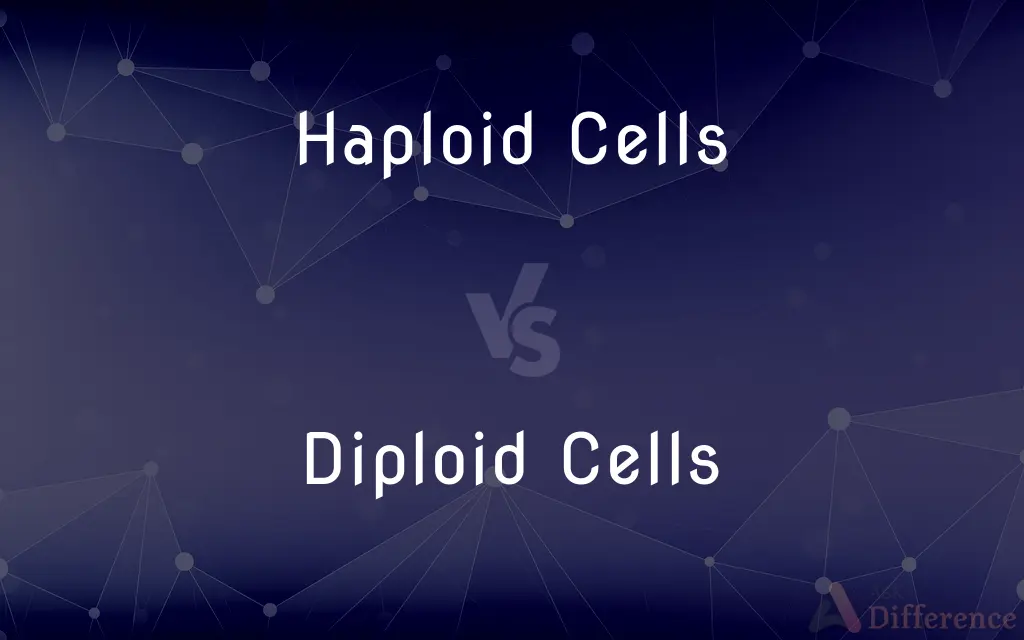Haploid Cells vs. Diploid Cells — What's the Difference?
Edited by Tayyaba Rehman — By Fiza Rafique — Published on November 21, 2023
Haploid Cells contain one set of chromosomes, while Diploid Cells have two sets, typically one from each parent.

Difference Between Haploid Cells and Diploid Cells
Table of Contents
ADVERTISEMENT
Key Differences
Haploid Cells and Diploid Cells are essential components of the life cycle of many organisms, but they differ fundamentally in their genetic content. Haploid Cells contain a single set of chromosomes, half the usual number in a body cell. Conversely, Diploid Cells possess two sets of chromosomes, one inherited from each parent.
In the realm of sexual reproduction, both Haploid Cells and Diploid Cells play critical roles. The reproductive cells or gametes (like sperm and eggs in animals) are Haploid Cells, ensuring that when fertilization occurs, the resulting zygote has the standard diploid number of chromosomes. Diploid Cells, on the other hand, make up the majority of an organism's body cells, encompassing everything from skin cells to muscle cells.
The process of meiosis creates Haploid Cells. During this cellular division, Diploid Cells are divided to produce four non-identical Haploid Cells, each with half the original chromosome number. This process ensures genetic diversity, as each of the resulting Haploid Cells is genetically distinct. In contrast, Diploid Cells arise from a process called mitosis, wherein a single cell divides to create two genetically identical daughter cells, each maintaining the diploid number of chromosomes.
Understanding the difference between Haploid Cells and Diploid Cells is crucial in the field of genetics. While Haploid Cells introduce genetic variation and are essential for sexual reproduction, Diploid Cells maintain the genetic stability and identity of an organism.
Comparison Chart
Chromosome Number
One set
Two sets
ADVERTISEMENT
Role in Reproduction
Gametes
Body cells
Origin Process
Meiosis
Mitosis
Genetic Variation
High variation due to recombination
Genetically identical to parent cell
Examples in Humans
Sperm and egg cells
Skin, muscle, and bone cells
Compare with Definitions
Haploid Cells
Cells containing a single set of chromosomes.
In humans, Haploid Cells include sperm and egg cells.
Diploid Cells
Replicate via mitosis.
Mitosis ensures that Diploid Cells divide into two identical daughter cells.
Haploid Cells
Gametes responsible for sexual reproduction.
Fertilization between Haploid Cells results in a diploid zygote.
Diploid Cells
Preserve an organism's genetic identity.
Diploid Cells carry the genetic information from both parents.
Haploid Cells
Produced through the process of meiosis.
Meiosis divides a diploid cell into four distinct Haploid Cells.
Diploid Cells
Include most of an organism's body cells.
From the brain to the heart, most of our cells are Diploid Cells.
Haploid Cells
Essential for introducing genetic variation.
The recombination in Haploid Cells ensures offspring are genetically unique.
Diploid Cells
Cells containing two sets of chromosomes.
Most human cells, like skin cells, are Diploid Cells.
Haploid Cells
Contain half the chromosomes of typical body cells.
While skin cells are diploid, sperm cells are Haploid Cells.
Diploid Cells
Result from the fusion of two haploid gametes.
When a sperm and egg merge, they form a diploid zygote.
Common Curiosities
What's the main difference between Haploid Cells and Diploid Cells?
Haploid Cells contain one set of chromosomes, while Diploid Cells have two sets.
Are body cells typically haploid or diploid?
Body cells are typically Diploid Cells.
How are Diploid Cells formed?
Diploid Cells form when two Haploid Cells fuse during fertilization.
Can Haploid Cells become diploid?
Yes, when two Haploid Cells (like sperm and egg) merge, they form a Diploid Cell.
Which cell division process produces Haploid Cells?
Haploid Cells are produced through meiosis.
Where are Haploid Cells found in humans?
Haploid Cells are found as gametes, specifically sperm and egg cells, in humans.
Can an organism survive with only Haploid Cells?
Some organisms, like certain fungi, have life stages that exist solely as Haploid Cells.
Why is it important for gametes to be haploid?
It ensures that upon fertilization, the chromosome number remains consistent across generations.
Do all organisms have Haploid Cells and Diploid Cells?
Most sexually reproducing organisms have both, but the exact life cycle stages vary.
How does genetic variation arise in Haploid Cells?
Through recombination and random segregation during meiosis.
Are Diploid Cells always genetically identical to each other?
No, only the cells resulting from mitosis are identical to the parent cell.
How do organisms benefit from having Diploid Cells?
Diploid Cells provide genetic stability and can repair damaged DNA using the second set of chromosomes.
Why is the distinction between Haploid Cells and Diploid Cells important in genetics?
It's crucial for understanding inheritance, genetic variation, and the life cycle of organisms.
Are the chromosomes in Diploid Cells identical?
No, one set comes from each parent, so they can be genetically different.
What role does mitosis play in Diploid Cells?
Mitosis divides Diploid Cells to produce two identical daughter cells.
Share Your Discovery

Previous Comparison
Qatar Airways vs. Turkish Airlines
Next Comparison
Volvo S40 vs. Volvo S60Author Spotlight
Written by
Fiza RafiqueFiza Rafique is a skilled content writer at AskDifference.com, where she meticulously refines and enhances written pieces. Drawing from her vast editorial expertise, Fiza ensures clarity, accuracy, and precision in every article. Passionate about language, she continually seeks to elevate the quality of content for readers worldwide.
Edited by
Tayyaba RehmanTayyaba Rehman is a distinguished writer, currently serving as a primary contributor to askdifference.com. As a researcher in semantics and etymology, Tayyaba's passion for the complexity of languages and their distinctions has found a perfect home on the platform. Tayyaba delves into the intricacies of language, distinguishing between commonly confused words and phrases, thereby providing clarity for readers worldwide.
















































